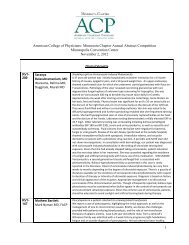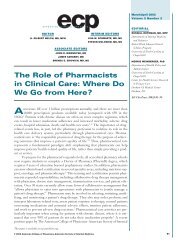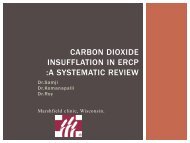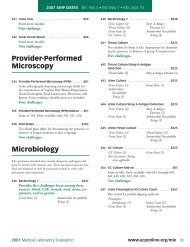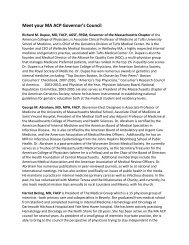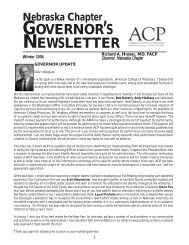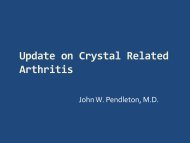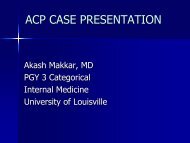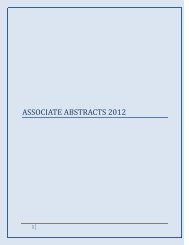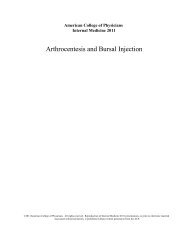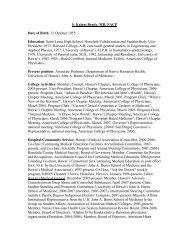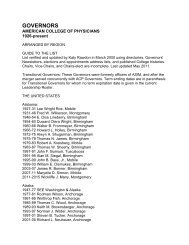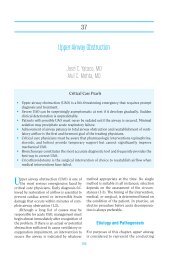Ultrasound - American College of Physicians
Ultrasound - American College of Physicians
Ultrasound - American College of Physicians
You also want an ePaper? Increase the reach of your titles
YUMPU automatically turns print PDFs into web optimized ePapers that Google loves.
Focused Bedside<br />
<strong>Ultrasound</strong><br />
Seeing is Understanding<br />
Daryl G Morrical MD, FCCP, FACP<br />
History <strong>of</strong> Medical <strong>Ultrasound</strong><br />
1988 – report on echocardiography<br />
performed by ER physicians<br />
1989 use <strong>of</strong> thoracic U/S by Lichtenstein<br />
Early 1990’s - FAST exam for trauma<br />
2001 ER guidelines for emergency<br />
ultrasound<br />
2010 Consensus statement from <strong>American</strong><br />
Society <strong>of</strong> Echocardiography and <strong>American</strong><br />
<strong>College</strong> Emergency <strong>Physicians</strong><br />
Should a Hand-carried <strong>Ultrasound</strong><br />
Machine Become Standard Equipment<br />
for Every Internist?<br />
Decades since any new equipment in<br />
internist’s black bag<br />
Stethoscope, neurologic hammer, otoscope,<br />
ophthalmoscope avail 200 years<br />
Hand carried ultrasound equipment extends<br />
physical exam – cost $9K to $40K<br />
J Alpert, Am J Med Jan 2009<br />
History <strong>of</strong> Medical <strong>Ultrasound</strong><br />
Developed from principles <strong>of</strong> sonar from<br />
World War I<br />
U/S images abdominal disease published<br />
1958<br />
– Early machines required subject be immersed in<br />
water<br />
1967 report <strong>of</strong> pleural effusion by U/S<br />
1971 – U/S for hemoperitoneum in patient<br />
with blunt trauma<br />
History <strong>of</strong> Medical <strong>Ultrasound</strong><br />
March 2012 Practice Guidelines for Central<br />
Venous Access from ASA<br />
Small hand-held units now available and<br />
used by multiple specialties<br />
Should a Hand-carried <strong>Ultrasound</strong><br />
Machine Become Standard Equipment<br />
for Every Internist?<br />
Cardiac - LV assessment, volume status, valvular<br />
disease, pericardial disease<br />
Vascular disease -carotid, abdominal aortic<br />
aneurysm<br />
Musculoskeletal - joint effusion, tendon injury<br />
Renal system - kidney size, obstruction, volume<br />
status<br />
Endocrine -thyroid nodule, solid vs cystic<br />
GI - ascites, gallstones, splenomegaly<br />
Pulmonary – effusions<br />
Procedural guidance<br />
J Alpert, Am J Med Jan 2009<br />
11/23/2012<br />
1
Selected Applications <strong>of</strong> Point-<strong>of</strong>-Care Ultrasonography, According to<br />
Medical Specialty<br />
Moore CL, Copel JA. N Engl J Med 2011;364:749-757.<br />
Range <strong>of</strong> Applications<br />
Critical Care<br />
Vascular ultrasonography<br />
– Vascular access, venous thrombosis<br />
Critical care echo<br />
– LV and RV size and function, pericardial disease<br />
(effusion/tamponade), valvular regurgitation,<br />
fluid status/responsiveness<br />
Making the Case<br />
Critical Care <strong>Ultrasound</strong><br />
Pulmonary ultrasound (lung sliding, A lines,<br />
B lines) not being done by others at present<br />
– and pleural ultrasound not fully utilized<br />
Integrates multiple disciplines – would<br />
require vascular tech, abdominal tech, and<br />
echo tech to do critical care ultrasound<br />
Reduces radiation exposure<br />
Reduces need to transport patient<br />
Range <strong>of</strong> Applications<br />
Critical Care<br />
Pleural ultrasonography<br />
– Effusion, pneumothorax (more sensitive than<br />
CXR – may be similar to CT)<br />
Lung ultrasonography<br />
– Consolidation, air bronchograms,<br />
alveolar/interstitial syndrome<br />
(Chest Oct 2012 U/S in dx and f/u <strong>of</strong> CAP)<br />
Abdominal ultrasonography<br />
– Hydronephrosis, AAA, bladder obstruction,<br />
ascites, diaphragmatic function<br />
Making the Case<br />
Critical Care <strong>Ultrasound</strong><br />
New imaging paradigm – real time<br />
assessment, not static image for later<br />
review by radiology or cardiology<br />
Repeated as illness evolves – extends<br />
physical exam<br />
Complementary to current imaging – goal<br />
directed to answer questions, not organ<br />
based complete studies<br />
Recorded image allows others to view<br />
results and compare with prior findings<br />
Making the Case<br />
Critical Care <strong>Ultrasound</strong><br />
Allows rapid assessment <strong>of</strong> shock states –<br />
differentiate sepsis, CHF, pulmonary<br />
embolism, hypovolemia, pericardial<br />
tamponade (Chest Oct 2012)<br />
Recommended by Agency for Healthcare<br />
Research and Quality and ASA for IJ central<br />
line placement, required by ACGME for ER<br />
residency and pulmonary/critical care<br />
fellowships<br />
11/23/2012<br />
2
Making the Case<br />
Critical Care <strong>Ultrasound</strong><br />
Improved procedural safety – internal<br />
jugular and subclavian line, thoracentesis<br />
May alter treatment approach in 25 – 50%<br />
<strong>of</strong> critically ill patients<br />
Patients/families appreciate images and<br />
time spent at bedside<br />
Basic <strong>Ultrasound</strong> Physics<br />
<strong>Ultrasound</strong> - sound with frequency >20 kHz<br />
– For clinical purpose usually 2-10 MHz<br />
Speed <strong>of</strong> propagation 1540 m/sec in s<strong>of</strong>t tissue –<br />
determined by density and stiffness <strong>of</strong> medium<br />
– 330 m/sec in air<br />
– 1497 m/sec in water<br />
Sound generated by piezoelectric crystals –<br />
transducer produces sound and listens for echo –<br />
deeper structure generates later echo<br />
Basic <strong>Ultrasound</strong> Physics<br />
Interactions <strong>of</strong> sound with tissue<br />
– Attenuation<br />
Varies with signal frequency<br />
– High frequency signal gives better resolution but<br />
less penetration<br />
Varies with tissue density<br />
– Attenuation <strong>of</strong> fluid < fat < muscle < fibrous<br />
tissue < calcifications and bone<br />
– Artifacts<br />
Reverberation, ring down, mirror-image, reflection,<br />
enhancement, attenuation<br />
Comparison <strong>of</strong> Effectiveness <strong>of</strong> Hand-<br />
Carried <strong>Ultrasound</strong> to Bedside<br />
Cardiovascular Physical Examination<br />
2 medical students with 18 hrs echo training<br />
compared to 5 cardiologists physical exam –<br />
standard echo as gold standard<br />
61 patients, 239 abnormalities on echo<br />
Students identified 75% <strong>of</strong> abnormalities,<br />
cardiologists 49%<br />
93% (student) vs 62% (card) for lesions<br />
causing systolic murmur; 75% vs 16% for<br />
lesions causing diastolic murmur<br />
Basic <strong>Ultrasound</strong> Physics<br />
<strong>American</strong> Journal <strong>of</strong><br />
Cardiology Oct 2005<br />
Interactions <strong>of</strong> sound with tissue<br />
– Echo occurs at boundary <strong>of</strong> 2 materials<br />
with different acoustic impedance<br />
Simple fluid – no echo, black image<br />
Small difference –weak echo, gray image<br />
Large difference, strong echo, white image<br />
Very large – ultrasound totally reflected, unable to see<br />
beyond border (air, bone)<br />
– Reflection, refraction<br />
Angle <strong>of</strong> surface<br />
Staph sepsis, incidental finding CHF<br />
Enhancement, attenuation<br />
Pt with pneumonia,<br />
incidental finding<br />
11/23/2012<br />
3
Mirror image Reverberation<br />
Basic (B-Mode) Two-Dimensional <strong>Ultrasound</strong> Image<br />
Moore CL, Copel JA. N Engl J Med 2011;364:749-757.<br />
Basic <strong>Ultrasound</strong> Physics<br />
Return signal displays<br />
– Signal amplitude displayed as brightness<br />
(B mode - brightness)<br />
– Signal depth/amplitude on a time plot (M<br />
mode – motion)<br />
Gain<br />
Near field<br />
Far field<br />
Autogain<br />
Depth<br />
Exam type<br />
Caliper<br />
Clip<br />
Save<br />
Freeze<br />
2D<br />
Knobology<br />
<strong>Ultrasound</strong> Guidance for Vascular Access<br />
Moore CL, Copel JA. N Engl J Med 2011;364:749-757.<br />
11/23/2012<br />
4
Thoracic <strong>Ultrasound</strong><br />
Air/fluid ratio leads to different<br />
patterns<br />
– Pleural effusion<br />
– Alveolar consolidation<br />
– Alveolar/interstitial syndrome<br />
– Normal lung<br />
– Pneumothorax<br />
Effusion p perforated ulcer<br />
Curtain sign R base<br />
Severe sepsis, CHF<br />
Lung cancer<br />
Severe sepsis<br />
Lung sliding point<br />
Acute pulmonary edema<br />
Amiodarone lung<br />
Lung sliding<br />
CHF , recent MI CHF, chronic effusion<br />
CHF, staph on cultures Severe mitral regurg<br />
22 yo with pneumonia<br />
85 yo with heart failure<br />
11/23/2012<br />
5
Thora on R,<br />
450 ml<br />
transudate<br />
93 yo with hx<br />
smoking prior to<br />
CABG 1996, afib,<br />
now with<br />
progressive<br />
dyspnea, EF 25%<br />
with mild mitral<br />
insuff, mild -mod<br />
aortic stenosis,<br />
Na 122, creat 1.6<br />
54 yo smoker<br />
with 3 rd episode<br />
hypercarbic resp<br />
failure in 6 weeks<br />
– now basilar<br />
density after<br />
extubation, no<br />
leg clots by<br />
venous<br />
compression<br />
Intubated few days later<br />
despite diuresis with<br />
refractory hypoxemia, BP<br />
70’s p intubation<br />
R base<br />
Post thoracentesis<br />
Pleural results - LDH 99, prot 4.5, WBC<br />
1030 (67% polys)<br />
Needle biopsy pleural nodule –<br />
small cell cancer<br />
11/23/2012<br />
6
51 yo with 3 yr hx metastatic colon ca, few week<br />
progressive cough and dypsnea<br />
Former smoker with<br />
weight loss<br />
Main carina R main bronchus<br />
Distal L main bronchus<br />
11/23/2012<br />
7
Images from Yale<br />
Interstitial disease<br />
Lung cancer<br />
Resp failure p C section<br />
11/23/2012<br />
8
49 yo smoker with few month chest cold with dyspnea, copious<br />
clear sputum, weight loss – presented for bronch with HR 130,<br />
BP 150, severe dyspnea, leg swelling, chest pain<br />
Distal trachea<br />
ESRD, HBP<br />
Septic shock<br />
COPD, edema<br />
11/23/2012<br />
9
R base L base<br />
72 yo former smoker with HBP, recent<br />
CABG in setting NSTEMI and<br />
pulmonary edema, transferred from<br />
rehab with leg swelling, renal insuff<br />
BNP 8700<br />
L base<br />
22 with recent pneumonia and iv drug use<br />
R anterior chest L lateral base<br />
L posterior base<br />
67 yo with hx CAD now with<br />
dyspnea and chest discomfort -<br />
cardiology ordered CT after<br />
focused bedside study<br />
After 375 ml thoracentesis<br />
WBC 520, LDH 93, prot 2.6<br />
11/23/2012<br />
10
R com femoral compression R superficial femoral<br />
R popliteal<br />
59 yo with sudden dyspnea, intubated at home with frothy secretions,<br />
mild mitral regurg by echo last year<br />
Post 4 days heparin Rx Pre treatment<br />
Decreased urine output 36 hours later<br />
despite good BP and partial CXR clearing<br />
11/23/2012<br />
11
59 yo nonsmoker with cough, confusion, dyspnea after<br />
laparoscopic cholecystectomy for acute cholecystitis<br />
70 yo with peripheral vascular disease, DM, and now sudden dyspnea<br />
with hypertension after transfusion– no known heart disease<br />
50 yo smoker with untreated heart disease and arrest<br />
while playing drums<br />
Had cricothyroidotomy at outside hospital after<br />
intubation attempts unsuccessful<br />
Transudate<br />
11/23/2012<br />
12
81-year-old with small smoking history, chronic atrial<br />
fibrillation on Coumadin, rheumatoid arthritis, episode <strong>of</strong> C.<br />
difficile colitis 2 months ago, chronic hydronephrosis <strong>of</strong> the<br />
right kidney now with hypotension and diarrhea<br />
Patient complaint <strong>of</strong> lower<br />
abdominal fullness p surgery<br />
despite Foley<br />
R common femoral<br />
R kidney<br />
L common femoral<br />
L kidney<br />
Acute renal failure in immobile patient from group home<br />
Gallbladder Peristalsis LUQ<br />
Scan lower abdomen R kidney<br />
R common femoral<br />
Hx recurrent CNS tumor, now<br />
with aspiration pneumonia,<br />
thrombocytopenia and leg<br />
swelling, + HIT screen<br />
Foley catheter, air injected<br />
Scan from prox to distal femoral<br />
11/23/2012<br />
13
80 yo with AICD x 6yrs, on warfarin 5 months for DVT, progressive dyspnea<br />
and leg swelling<br />
Before thoracentesis Post thoracentesis – 20 ml<br />
Pleural fluid – WBC 330, 98% lymphs, protein 2.5,<br />
LDH 120, glucose 86<br />
L common femoral<br />
L popliteal<br />
R effusion L effusion<br />
L superficial femoral<br />
85 yo with CHF and prior<br />
parapneumonic effusion<br />
Post thoracentesis<br />
11/23/2012<br />
14
L effusion<br />
L effusion 6 months later<br />
47 yo former smoker with CHF, weight loss, resected paraesophageal hernia<br />
with partial esophagectomy<br />
Chronic R effusion<br />
Scan through L lung base<br />
Initial bronch April 6, repeat April 11<br />
shown above – partial obstruction L<br />
main, complete occlusion RLL<br />
Post thoracentesis –<br />
pleural rub by exam<br />
R lung base with respiration<br />
L base pre bronch<br />
Post bronch L base<br />
11/23/2012<br />
15
45 yo with prior stroke, remote necrotizing<br />
pancreatitis/splenectomy, bilat DVT 6 months ago on<br />
warfarin, now with dyspnea several days after fall in shower<br />
Drained 700 ml with thoracentesis –<br />
after reversal coags surgery placed<br />
large bore chest tube- 4800 ml<br />
removed by next morning<br />
L lateral view thorax<br />
Upward diaphragmatic<br />
movement with inspiration<br />
74 yo with persistent resp failure after CABG and post surgery inferior MI<br />
11/23/2012<br />
16
80 yo with hypertension<br />
and sudden dyspnea<br />
69 yo smoker with hypotension after<br />
perforated ulcer repair<br />
R thorax<br />
8 days later – still<br />
failure to wean<br />
After hydration<br />
and extubation<br />
R lung base L lung base<br />
72 yo 1.5 ppd smoker with progressive weakness, dyspnea,<br />
mild clubbing fingers, 10 mm pulsus, 7 cm R paratracheal<br />
mass, sodium 118<br />
Bronchoscopy with TBNA - adenocarcinoma<br />
L thorax<br />
Apical 4 view<br />
11/23/2012<br />
17
82 yo with obesity, DM, chronic anticoagulation, now with<br />
ascites, renal failure, and cardiopulmonary arrest<br />
700 ml exudative fluid removed from R<br />
Chronic resp failure on warfarin, OSA, new renal<br />
failure, arrested in radiology<br />
52 yo with stroke, hx iv drug use<br />
11/23/2012<br />
18
61 yo with pancreatitis, refractory hypotension on dobutrex and<br />
pressors, lactate 20, and arrest x 3 overnight<br />
87 yo with bullous lung disease, CAD , recurrent pneumonia, M avium, afib<br />
on Coumadin, AAA now with fall, rib fractures, and progressive azotemia and<br />
sats high 80’s on 100% high flow O2<br />
Elderly pt with COPD<br />
89 yo nonsmoker with hx HBP and ESRD on dialysis x 3 years, PE diagnosed<br />
4 months ago p drive to Florida, pacer for heart block 11 yrs ago, and now<br />
recurrent Staph bacteremia<br />
11/23/2012<br />
19
R kidney<br />
L kidney<br />
R kidney L kidney<br />
92 yo with neurogenic bladder now with oliguria, chills/weakness -minimal cloudy<br />
urine from bladder<br />
Required norepinephrine at 70 mcg/min to maintain BP<br />
WBC 19900, Hgb 12.5 BUN 44. creat 3.9, HCO3 20, lactate 6.4<br />
6 hrs later HCO3 14 , WBC 51200 with 37% bands, essentially anuric<br />
Percutaneous nephrostomy by IR later in day – clear on L, purulent on R<br />
77 yo with stroke, CAD, DM, G tube, c<strong>of</strong>fee ground emesis,<br />
and hypotension with dilated renal pelvis on CT abd<br />
Ovarian cancer with ureteral stent ESRD with polycystic kidney<br />
11/23/2012<br />
20
L common femoral R common femoral<br />
L kidney R kidney<br />
Acute renal failure in immobile patient from group home<br />
79 yo with prior pelvic radiation now with confusion, hypotension,<br />
renal failure<br />
75 yo with hx squamous cell lung ca x 2 years on erlotinib –<br />
now with progressive dyspnea, new atrial fibrillation<br />
Foley catheter, air injected<br />
11/23/2012<br />
21
Assessment <strong>of</strong> fluid status<br />
Clinical experience “Making the same mistakes with<br />
increasing confidence over an impressive number <strong>of</strong><br />
years” Sceptic's Medical Dictionary -Michael<br />
O'Donnell<br />
30 – 60% <strong>of</strong> hypotensive pts on mechanical<br />
ventilation show no response to fluid administration<br />
– prediction would be helpful given potential for<br />
harm with excess fluids<br />
Physical exam, vital signs, and static parameters<br />
poorly predictive <strong>of</strong> response to volume expansion<br />
– CVP, PAOP, LV end diastolic area<br />
Assessment <strong>of</strong> fluid status<br />
Practical approach – pts with spontaneous<br />
breathing or on ventilator<br />
– IVC < 10 mm or hyperdynamic LV with small end systolic<br />
volume – high probability <strong>of</strong> fluid response<br />
– IVC > 25 mm – low prob <strong>of</strong> response<br />
– IVC 10-25 mm - indeterminate<br />
“A line” pattern has 90% specificity for PAOP < 13<br />
and may be used to guide safe fluid administration<br />
– filling pressures uncertain with B lines<br />
IVC variability with sniff reported in outpatient<br />
dialysis population to gauge volume status<br />
(IVCCI > 75% hypovolemic, 40-75% euvolemic, < 40% hypervolemic)<br />
Assessment <strong>of</strong> fluid status<br />
IVC variability >12% in pts passive on mech vent<br />
with TV 8-10 ml/kg implies responsiveness to fluid<br />
bolus (8 ml/kg)– lower tidal volumes, pt effort, and<br />
arrhythmias decrease utility in clinical practice<br />
Dynamic parameters<br />
– Variation in venous return during ventilation or passive leg<br />
raising to assess whether patient on steep portion <strong>of</strong><br />
Starling curve (volume responsive) or flat portion – RV<br />
failure and increased abd pressure may limit validity<br />
– PPV (Pulse pressure variation -art line), SPV (Systolic<br />
pressure variation), SVV (Stroke volume variation - VTI by<br />
Doppler at LVOT), Brachial artery peak velocity variation<br />
11/23/2012<br />
22



